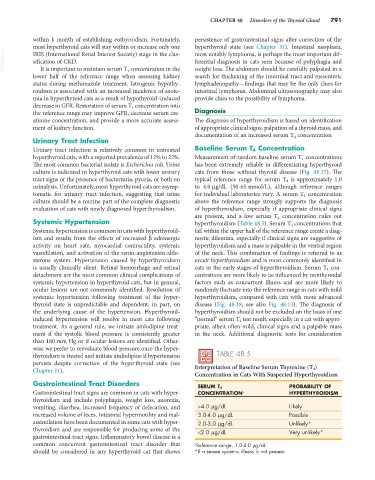Page 819 - Small Animal Internal Medicine, 6th Edition
P. 819
CHAPTER 48 Disorders of the Thyroid Gland 791
within 1 month of establishing euthyroidism. Fortunately, persistence of gastrointestinal signs after correction of the
most hyperthyroid cats will stay within or increase only one hyperthyroid state (see Chapter 31). Intestinal neoplasia,
VetBooks.ir IRIS (International Renal Interest Society) stage in the clas- most notably lymphoma, is perhaps the most important dif-
ferential diagnosis in cats seen because of polyphagia and
sification of CKD.
It is important to maintain serum T 4 concentration in the
search for thickening of the intestinal tract and mesenteric
lower half of the reference range when assessing kidney weight loss. The abdomen should be carefully palpated in a
status during methimazole treatment. Iatrogenic hypothy- lymphadenopathy—findings that may be the only clues for
roidism is associated with an increased incidence of azote- intestinal lymphoma. Abdominal ultrasonography may also
mia in hyperthyroid cats as a result of hypothyroid–induced provide clues to the possibility of lymphoma.
decrease in GFR. Restoration of serum T 4 concentration into
the reference range may improve GFR, decrease serum cre- Diagnosis
atinine concentration, and provide a more accurate assess- The diagnosis of hyperthyroidism is based on identification
ment of kidney function. of appropriate clinical signs, palpation of a thyroid mass, and
documentation of an increased serum T 4 concentration.
Urinary Tract Infection
Urinary tract infection is relatively common in untreated Baseline Serum T 4 Concentration
hyperthyroid cats, with a reported prevalence of 12% to 22%. Measurement of random baseline serum T 4 concentrations
The most common bacterial isolate is Escherichia coli. Urine has been extremely reliable in differentiating hyperthyroid
culture is indicated in hyperthyroid cats with lower urinary cats from those without thyroid disease (Fig. 48.17). The
tract signs or the presence of bacteriuria, pyuria, or both on typical reference range for serum T 4 is approximately 1.0
urinalysis. Unfortunately, most hyperthyroid cats are asymp- to 4.0 µg/dL (50-65 mmol/L), although reference ranges
tomatic for urinary tract infection, suggesting that urine for individual laboratories vary. A serum T 4 concentration
culture should be a routine part of the complete diagnostic above the reference range strongly supports the diagnosis
evaluation of cats with newly diagnosed hyperthyroidism. of hyperthyroidism, especially if appropriate clinical signs
are present, and a low serum T 4 concentration rules out
Systemic Hypertension hyperthyroidism (Table 48.5). Serum T 4 concentrations that
Systemic hypertension is common in cats with hyperthyroid- fall within the upper half of the reference range create a diag-
ism and results from the effects of increased β-adrenergic nostic dilemma, especially if clinical signs are suggestive of
activity on heart rate, myocardial contractility, systemic hyperthyroidism and a mass is palpable in the ventral region
vasodilation, and activation of the renin-angiotensin-aldo- of the neck. This combination of findings is referred to as
sterone system. Hypertension caused by hyperthyroidism occult hyperthyroidism and is most commonly identified in
is usually clinically silent. Retinal hemorrhage and retinal cats in the early stages of hyperthyroidism. Serum T 4 con-
detachment are the most common clinical complications of centrations are more likely to be influenced by nonthyroidal
systemic hypertension in hyperthyroid cats, but in general, factors such as concurrent illness and are more likely to
ocular lesions are not commonly identified. Resolution of randomly fluctuate into the reference range in cats with mild
systemic hypertension following treatment of the hyper- hyperthyroidism, compared with cats with more advanced
thyroid state is unpredictable and dependent, in part, on disease (Fig. 48.18; see also Fig. 48.13). The diagnosis of
the underlying cause of the hypertension. Hyperthyroid- hyperthyroidism should not be excluded on the basis of one
induced hypertension will resolve in most cats following “normal” serum T 4 test result, especially in a cat with appro-
treatment. As a general rule, we initiate amlodipine treat- priate, albeit often mild, clinical signs and a palpable mass
ment if the systolic blood pressure is consistently greater in the neck. Additional diagnostic tests for consideration
than 180 mm Hg or if ocular lesions are identified. Other-
wise we prefer to reevaluate blood pressure once the hyper-
thyroidism is treated and initiate amlodipine if hypertension TABLE 48.5
persists despite correction of the hyperthyroid state (see Interpretation of Baseline Serum Thyroxine (T 4 )
Chapter 11).
Concentration in Cats With Suspected Hyperthyroidism
Gastrointestinal Tract Disorders SERUM T 4 PROBABILITY OF
Gastrointestinal tract signs are common in cats with hyper- CONCENTRATION + HYPERTHYROIDISM
thyroidism and include polyphagia, weight loss, anorexia,
vomiting, diarrhea, increased frequency of defecation, and >4.0 µg/dL Likely
increased volume of feces. Intestinal hypermotility and mal- 3.0-4.0 µg/dL Possible
assimilation have been documented in some cats with hyper- 2.0-3.0 µg/dL Unlikely*
thyroidism and are responsible for producing some of the <2.0 µg/dL Very unlikely*
gastrointestinal tract signs. Inflammatory bowel disease is a
common concurrent gastrointestinal tract disorder that + Reference range: 1.0-4.0 µg/dL
should be considered in any hyperthyroid cat that shows *If a severe systemic illness is not present.

